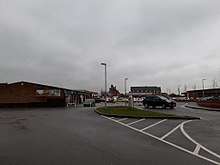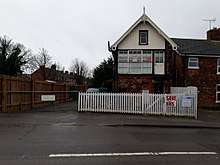Louth railway station
Louth railway station was a station in Louth, Lincolnshire, England. It served as a junction for several different now closed lines which converged on the town.[3]
| Louth | |
|---|---|
 Louth station frontage | |
| Location | |
| Place | Louth |
| Area | Lincolnshire |
| Coordinates | 53.3714°N 0.00157°E |
| Grid reference | TF333879 |
| Operations | |
| Original company | East Lincolnshire Railway |
| Pre-grouping | Great Northern Railway |
| Post-grouping | LNER |
| Platforms | 3 |
| History | |
| 1 March 1848 | Opened |
| 5 Oct 1970 | Closed to regular passenger traffic[1] |
| 22 Dec 1980 | Closed[1] |
| Listed status | |
| Listed feature | Louth Railway station |
| Listing grade | Grade II listed |
| Entry number | 1063202[2] |
| Added to list | 18 February 1974 |
| Disused railway stations in the United Kingdom | |
| Closed railway stations in Britain A B C D–F G H–J K–L M–O P–R S T–V W–Z | |
The closure of the station has left Louth which has over 16,000 residents the largest town in Lincolnshire without a railway station.
History
The foundation stone of Louth railway station was formally laid on 8 July 1847 by Miss Charlotte Alington Pye, a popular ballad writer of the time (who used the pseudonym "Claribel" from a Tennyson poem).[4][5] The architects of the station buildings were John Grey Weightman and Matthew Ellison Hadfield of Sheffield.[6]
The station was damaged by bombing on 19 February 1941 killing a local man, George Bradley, who was the fireman of an engine shunting in the goods yard.[7]
Louth Station was closed to passengers in 1970. The line northwards to Grimsby remained open for freight until 1980. A 5-car diesel multiple unit formed a special into Louth on 20 December 1980; at the time, the only remaining track was into the bay platform No. 1. The station building was saved from demolition and converted into flats.[8] It is a Grade II listed building.[2]

Preservation future
The Lincolnshire Wolds Railway plans to eventually extend their running line to Louth, however the original station building and the surrounding area cannot be reused as the terminus of the LWR, as it has been converted for residential use, and the former goods yard is now a mix of housing and industrial/retail outlets.
A proposed new station will be built approx. 3/4 mile to the north of the original station. Louth North signalbox still stands in its original position by the adjacent level crossing. This has now been converted to a house.

Route
| Preceding station | Disused railways | Following station | ||
|---|---|---|---|---|
| Fotherby Halt | Great Northern Railway East Lincolnshire Line |
Legbourne Road | ||
| Terminus | Great Northern Railway Mablethorpe loop railway |
Grimoldby | ||
| Hallington | Great Northern Railway Louth to Bardney Line |
Terminus |
References
- Butt, R. V. J. (1995). The Directory of Railway Stations: details every public and private passenger station, halt, platform and stopping place, past and present (1st ed.). Sparkford: Patrick Stephens Ltd. p. 150. ISBN 978-1-85260-508-7. OCLC 60251199.
- Historic England. "Louth Railway Station (1063202)". National Heritage List for England. Retrieved 28 June 2017.
- British Railways Atlas. 1947. p. 17
- "Louth History" (PDF). Archived from the original (PDF) on 5 October 2011. Retrieved 14 March 2009.
- "Historic Louth". Archived from the original on 10 June 2008. Retrieved 14 March 2009.
- "General Remarks". Hull Packet. England. 3 March 1848. Retrieved 3 March 2017 – via British Newspaper Archive.
- "Louth Leader - Sheila recalls her dad's tears over pal killed in WWII raid". Retrieved 15 March 2009.
- "Louth station". Archived from the original on 1 July 2009. Retrieved 15 March 2009.